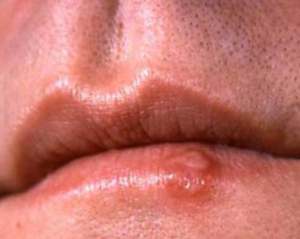

MedFriendly®


Orolabial Herpes
Orolabial herpes is a suddenly occurring infection
affecting the mouth and lips caused by a virus known as
herpes simplex (type 1).
WHAT ARE THE SIGNS AND SYMPTOMS OF
OROLABIAL HERPES?
The characteristic sign of orolabial herpes is blisters in
or around the lips and mouth area. More specifically,
groups of small, fluid-filled blisters with very small red
bottoms erupt on the roof of the mouth, throat, gums,
and borders of the lips.
A lower lip herpes blister.
FEATURED BOOK: Herpes: Everything You Need to Know
The blisters (which are often called fever blisters or cold sores) may break and cause
unevenly shaped, red ulcers with swollen borders. Ulcers are open sores on the skin or
on a mucous membrane. A mucous membrane is one of four major types of thin sheets of
tissue that line or cover various parts of the body, such as the mouth and passages for
breathing. Other classic signs and symptoms of orolabial herpes include burning,
soreness, and swelling in the mouth and on the outer skin surface of the lips and mouth.
Signs and symptoms are usually the most severe during the initial infection and may be
preceded by a fever, headache, and sore throat, after which the gums may be red,
swollen, and bloody. Signs and symptoms generally last about a week to two weeks.
"Where Medical Information is Easy to Understand"™
WHEN DOES OROLABIAL HERPES OCCUR?
Orolabial herpes can occur at any time in life, but most commonly
occurs first as an infection in children and young adults.
IS OROLABIAL HERPES CONTAGIOUS?
Yes. The fluid inside of the blisters is highly contagious. This is why
someone with orolabial herpes should not kiss other people, share
eating utensils, cups, soap, make-up, towels, or washcloths.
Orolabial herpes is contagious as long as symptoms are present.
IS OROLABIAL HERPES RELATED TO GENITAL HERPES?
Sometimes orolabial herpes is related to genital herpes but other times it is not. Genital herpes is a
sexually transmitted disease caused by the herpes virus (type 2).
HOW IS OROLABIAL HERPES DIAGNOSED?
Orolabial herpes is diagnosed by a physician after physically examining the patient and the well-known,
characteristic blisters on the mouth and lips. Confirmation of the diagnosis can be obtained by scraping
the bottom of the blister (often with a Q-tip), smearing it on a slide, and examining it under a microscope
after a type of stain has been applied. The staining substance helps the doctor better identify if the sample
contains the herpes simplex virus (types 1 and 2). Sometimes, doctors use a staining substance that
reveals the presence of giant cells with more than one nucleus (the center structure of a cell). The
presence of these cells indicates the presence of the herpes virus. The cotton swab (as opposed to the
smear) can be examined for the presence of the herpes simplex virus.
There are more specific stains that contain antibodies specific to the herpes simplex virus (types 1 and
2). Antibodies are types of proteins that help defend the body by identifying and responding to foreign
invaders known as antigens. The herpes simplex virus presents to the body as a type of antigen. Specific
types of antibodies react to specific types of antigens. This reaction can be detected under the
microscope.
HOW IS OROLABIAL HERPES TREATED?
Ororlabial herpes can be treated by anti-viral medications that are taken by mouth or rubbed onto the skin.
One of the most popular ant-viral medications used for this purpose is acyclovir. Anti-viral medications
can help prevent the infection from spreading. Doctors are more likely to prescribe such medications if the
person (or someone the person lives with) has a weakened immune (defense) system. Anti-viral
medications are also more likely to be prescribed if the person suffers from frequent and/or severe
recurrences.
It is important to note that anti-viral medications have not been shown to decrease he severity of
symptoms in people with the average, run-of-the-mill form of orolabial herpes. In these cases, there are
special pain-relieving medications the doctor can recommend that can be rubbed onto blisters inside of
the mouth to reduce pain. Lastly, studies indicate that some home remedies may be beneficial such as
vitamin E, lysine, and lecithin. Lysine is a type of amino acid that plays a very important role in tissue
growth and repair. Amino acids are a group of chemical substances that form proteins. Lecithin is a
natural substance mostly derived from soybeans that contains substances which help it soften the skin
and protect it from infection.
WHAT IS THE PROGNOSIS FOR PEOPLE WITH OROLABIAL HERPES?
Although orolabial herpes can be successfully treated, symptoms tend to recur under conditions of
significant emotional/physical stress, fever, the common cold, sun exposure, tiredness, digestive
disturbance, and menstruation. Menstruation is the shedding of the lining of the uterus that generally
occurs once every 28 days in women who are not pregnant.
WHAT ELSE IS OROLABIAL HERPES KNOWN AS?
Orolabial herpes is also known as herpes labialis, herpes facialis, herpes simplex, Simplex virus, herpes
catarrhalis, and herpes febrilis.
WHAT IS THE ORIGIN OF THE TERM, OROLABIAL HERPES?
Orolabial herpes comes from the Latin word "oris" meaning "mouth, " the Latin word "labium" meaning "lip, "
and the Greek word "herpes" meaning "a spreading skin eruption." Put the words together and you get "a
spreading skin eruption (to the) mouth (and) lip."















